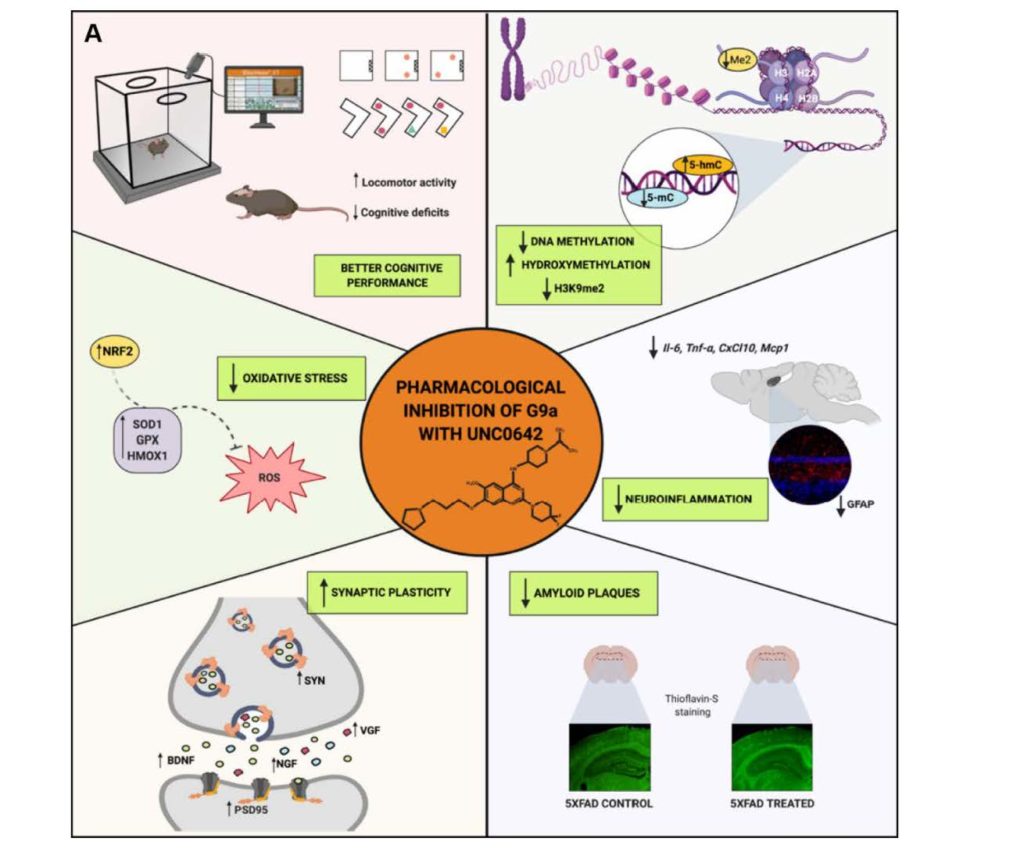
Neurodegeneration in ageing and neurodegenerative diseases
We focus our research in the study of the molecular mechanisms involved in behavioral abnormalities and cognitive decline, by using…

Dr. Mercè Pallàs
pallas@ub.edu
Section of Pharmacology and Toxicology
Faculty of Pharmacy and Food Sciences
University of Barcelona
Tel. 93 4024531
ORCID: 0000-0003-3095-4254
https://orcid.org/0000-0003-3095-4254
Scopus Author ID: 7003835718
Researcher ID: H-3129-2016
Neuropharmacology, neuroepigenetics, neurodegeneration and ageing group is devoted to study molecular pathways implicated in neurodegenerative processes and to perform early preclinical studies in vitro and in vivo studying new compound to fight against Alzheimer’s disease and senescence. After working several years with non pharmacological (Diet, exercise, caloric restriction) and pharmacological strategies (melatonin or resveratrol) in the context of aging, senescence and neurodegenerative diseases, as Alzheimer’s disease or Niemann-Pick C, the research group is currently interested in discern the precise mechanisms of action and the molecular pathways implicated of new drugs synthetized by ChemMedPharm group or other medical chemistry collaborators. These include small molecules targeting neuroinflammation, mitochondrial stress, oxidative stress in pathological senescence and the crossroad with epigenetics. Some of the pharmacological targets where we are looking for new drugs are soluble epoxide hydrolase, imidazoline 2 receptors and G9a/GLP methyltransferase.
We are three PI, Dr Christian Griñán-Ferrer, Dr Ana Guerrero and Dr Mercè Pallàs.
The group belongs to CIBERNED and GENiE network an specialized COST network in C. elegans.
Mercè Pallàs is Full Professor in Pharmacology in the Department of Pharmacology, Toxicology and Therapeutic Chemistry, Faculty of Pharmacy and Food Sciences of the University of Barcelona (UB). He is also a founder member of the Institute of Neuroscience of the Universitat de Barcelona (NeuroUB). She has over 25 years’ experience working on preclinical pharmacology, with focus on cognitive decline in ageing and neurodegenerative diseases, such as Alzheimer’s disease (AD). After her PhD in the UB (1991), she spent one year (1992-93) at the Instituto di Ricerche Farmacologiche Mario Negri (Italy) working within the group of Prof. Daniela Corda on GPCR. He returned to Barcelona in 1993 as Associate Professor and was later promoted to Full Professor in 2011.
She has participated as PI in several research projects from public funding agencies and in some research contract with Spanish pharmaceutical companies. She is co-inventor in several patent and patent applications, both in new chemical entities with biological activity. So far she has supervised 14 PhD Thesis, and several MSc Research projects.
Her teaching activities have been mainly focused on topics related to Pharmacology, Neuropharmacology, Pharmacology in R+D+I and Ageing.

Lecturer Professor of Pharmacology at the Faculty of Pharmacy and Food Science at the University of Barcelona (UB) since 2020. He received his Ph.D in the epigenetic modulation of Alzheimer’s disease (AD) (Biomedical Biotechnology) in 2016 at the UB. During doctoral thesis, he focused his knowledge in the epigenetic modulation of neurodegeneration and AD. Furthermore, the study of non-pharmacological interventions such as Environmental Enrichment (EE) paradigms in order to find new targets to prevent or cure the cognitive decline. His current research interest is the development of new chemical entities based on epigenetics to ameliorate and to prevent neurodegenerative diseases, including rare disease. He is also interested in the implications of the transgenerational epigenetic inheritance in the cognitive decline risk for the next generation. Pharmacology and drug discovery are the principle topics of his teaching activities in the Faculty of Pharmacy. He belongs to network GENiE from 2021

Ramón y Cajal Researcher at the Faculty of Pharmacy and Food Science of the University of Barcelona (UB) since 2023. She completed her PhD in Molecular Medicine at the University of Santiago de Compostela (USC), and held postdoctoral positions at the MRC London Institute of Medical Sciences (MRC LMS, Imperial College London, UK) and the UK Dementia Research Institute (UK DRI at University College London, The Francis Crick Institute, UK). Her postdoctoral research explored the potential of cellular senescence as a therapeutic target, leading to the identification of novel pharmacological modulators of senescence, including senolytic compounds (Guerrero et al. 2019, Nature Metabolism; Guerrero et al. 2020, Aging Cell) and drugs alleviating senescence (Guerrero et al. 2022, Nature Aging). Her current research programme explores the contribution of cellular senescence and ageing to neurodegeneration, with a particular focus on Alzheimer´s Disease.
ORCID es 0000-0002-4622-9201

I am a Pharmacy graduate by the University of Barcelona. As an undergraduate student, I spent time in the Neurosciences group led by Dr. M. Pallàs and Dr. C. Griñán-Ferré participating in different research projects. After graduating, I had the opportunity to do an internship in the Neurosciences Group in Maciel Group (Universidade do Minho, Braga), where I learned to work with C. Elegans through the study of new targets for Machado Joseph disease. In October 2020, I started my PhD studying the role of the histone methyltransferase G9a/GLP in neurodegeneration using C. elegans and mice as experimental models.

In 2019, I finished my studies of Human Biology in the Universitat Pompeu Fabra (UPF). Then, I studied a Master of Neuroscience in the Universitat de Barcelona (UB) and I performed my master thesis in the Neuropharmacology of Aging and Neurodegeneration group, in the Faculty of Pharmacy and Food Science. At present, I’m a Ph.D. student at the same laboratory under the supervision of Dr. M.Pallàs and Dr. C. Griñán-Ferré. In particular, I’m studying the behavioral and biochemical changes that cause the pharmacological inhibition of the soluble epoxide hydrolase enzyme in Alzheimer’s Disease using mice and C. elegans animal models.

Graduate in Biochemistry and Molecular Biology at the University Rovira i Virgili and Master student of Biomedical Research Student at the University Pompeu Fabra. She joined Neuropharmacology of Aging and Neurodegeneration group, in the Faculty of Pharmacy and Food Science, under Dr Griñán Ferré supervision to pursuit her PhD thesis on Pharmacological targets related with neuroepigenetic mechanisms.
ORCID: 0000-0002-5850-5058

She is a Pharmacy graduated from National University of Asunción (Paraguay). At 2021, She finished MSc program in Pharmaceutical Sciences (National University of Asunción, Paraguay). During the career and the MSc program, she has been involved in research projects about medicinal drugs and their effect in CNS. Recently she joined at the Dr. M. Pallàs and Dr. C. Griñán team, as an PhD student at Faculty of Pharmacy and Food Science at the Universitat de Barcelona, in the Neuropharmacology of Aging and Neurodegeneration group, to search the molecular pathways involved in the Alzheimer Disease and other neurodegenerative diseases. She is interested in new drugs to face cognitive decline in ageing and neurodegenerative diseases that exert effect at the Imidazoline receptors (I2-IR) in mice and the molecular pathways involved in their effect.
ORCID: 0000-0002-9666-333X
Alumni:
M Dolors Puigoriol-Illamola (PhD, 2020)
Foteini Vasilopoulou (PhD, 2021)
Júlia Companys-Alemany (PhD, 2022)
New insights on I2 imidazoline receptors role in neuroinflammation. Identification and validation as a target for Alzheimer’s disease Ministerio de Economia y Competitividad PID2022-138079OB-100. Funds: 150.000,00 From 2022 to 2025. PI: Mercè Pallàs
Validation of dual inhibition G9a/GSK-3b as a new therapeutic strategy for cognitive decline and Alzheimer’s disease. Ministerio de Economia y Competitividad PID2022-1390616-OA-100 .Funds: 130.000,00 From 2022 to 2025. PI: Christian Griñán Ferré
Understanding the Contribution of Cellular Senescence to Alzheimer’s Disease Ministerio de Economia y Competitividad PID2022-138829OA-100 Funds: 170.000,00 From 2022 to 2025. PI Ana Guerrero Lopez
Validation of a first in class candidate of a soluble epoxide hydrolase inhibitor to treat Alzheimer’s disease. Ministerio de Economia y Competitividad PDC2021-121096-C21. Funds: 150.000,00 From 2021 to 2023. PI: Mercè Pallàs
Soluble Epoxide hydrolase modulation in brain and peripheral tissues Ministerio de Economía y Competitividad. Ministerio de Economía y Competitividad PID2019-106285RB-C21. Funds: 133.100,00 From 2019 to 2022. PI: Mercè Pallàs
Estudio de una nueva diana farmacológica para la enfermedad de Alzheimer: modulación del estrés oxidativo y la función mitocondrial.SAF2016-77703-C2-1-R. Funds: 133.100,00 from: 2016 to:2019
Identificación de moduladores dietéticos del envejecimiento cognitivo y plasticidad cerebral, y evidencia del concepto de eficacia en la prevención/reversión del declive cognitivo. Ministerio de Economía y Competitividad. Universidad de Barcelona PCIN-2015-229 Funds: 120.000, from: 2016 from: 2018. PI: Mercè Pallas
Evaluación de la eficacia de inhibidores epigenéticos en modelos experimentales de patologías humana. Ministerio de Economía y Competitividad. Biomedicina (SAF) RETOS-COLABORACIÓN, dentro del Programa Estatal de Investigación, Desarrollo e innovación Orientada a los Retos de la Sociedad. Convocatoria 2015 ORYZON Genomics S.L./UB PI: Mercè Pallas /UAB de Barcelona. SRTC1500C003898XV0
Medicinal Chemistry and Pharmacology of Neurodegenerative Diseases SGRC – Ajuts de Suport als Grups de Recerca de Catalunya (SGR) – Agència de Gestió d’Ajuts Universitaris i de Recerca (AGAUR) 2017SGR106 Funds 20.000,00 , from: 2017 from: 2020. PI. Diego Muñoz-Torrero López-Ibarra
Regulación epigenética de la respuesta inflamatoria (RETOS COLABORACION) 2016 – 2018. Ref.RTC-2016-4955-1. Ministerio de Economia y Competitividad . IF: Mercè Pallàs
Contracts
Products in cognitive decline by using the senescence-accelerated murine P8 model (SAMP8) Biosearch S.A. Funds:37.073,17 From 2019 to 2020. Merce Pallas Lliberia
Products SDP on aging-hallmarks by using the Caenorhabditis elegans (C. elegans) APC EUROPE, S.A. Funds:15.158,28. From 2020 to 2021. PI. Merce Pallas Lliberia; Christian Griñán Ferré
Study of Biosearch Life products on AD-hallmarks by using the Caenorhabditis elegans (C. elegans) – Funds: 12.623,31 From: 2019 to: 2019 PI: Christian Griñan
A New family of sEH inhibitors for AD. CI17-00053 Fundació Caixa de Pensions ‘La Caixa’ Funds: 57.851,24 , from: 2017 From: 2019 PI: Mercè Pallàs; Carlos Galdeano
Novel compounds for the treatment of neurodegenerative disorders. CI18-00002 Fundació Caixa de Pensions ‘La Caixa’ Funds: 70.000 From: 2018 to: 2020 PI: Mercè Pallàs; Maria Carmen Escolano
Study of OG-S436 and OG-S437 effects on behavior. Cerebro espinal Fluid extraction in the senescence accelerated murine P8 model. Oryzon Genomics, S.A Funds: 69,907.75 , from: 2015 from: 2016 PI: Mercè Pallàs
Study of neuroprotective role of OG-S436 in the senescence accelerated murine P8 model. Oryzon Genomics, S.A Funds: 5.674,12, from: 2015 to: 2016 PI: Mercè Pallas
Study of anxiolytic activity of OG-S09 in the senescence accelerated murine P8 model. Oryzon Genomics, S.A Funds: 14.895, from: 2015 to : 2015 PI: Mercè Pallas
A New family of sEH inhibitors for AD. CI17-00053 Fundació Caixa de Pensions ‘La Caixa’ Funds: 57.851,24 , from: 2017 to: 2019 PI: Mercè Pallàs; Carlos Galdeano
Novel compounds for the treatment of neurodegenerative disorders. CI18-00002 Fundació Caixa de Pensions ‘La Caixa’ Funds: 70.000 From: 2018 to: 2020 PI: Mercè Pallàs; Maria Carmen Escolano
Products in cognitive decline by using the senescence-accelerated murine P8 model (SAMP8). Biosearch S.A. Funds: 073,17 €1 From: 2019 to: 2020. PI: Mercè Pallàs
Efficacy study of compounds OG-S2323, OG-S2324 and OG-S2325 on memory and social behavior in SAMP8 mice. Oryzon Genomics, S.A. Funds: 464,50 € From: 2019 to: 2020 PI: Mercè Pallàs
Inhibidors de l’epòxid hidrolasa soluble per fer front a la malaltia de Niemman-Pick C. 2018 LLAV 00007 Agència de Gestió d’Ajuts Universitaris i de Recerca AGAUR Funds: 20.000,00 € From: 2019 to: 2020 PI: Christian Griñán-Ferré
Synthetic I2 Imidazoline receptor ligands for prevention or treatment of human brain disorders.
María Carmen Escolano, Mercè Pallàs Lliberia, Christian Gaspar Griñán Ferré, Sònia Abás, Luis-Felipe Callado Hernando, Jesús A. García Sevilla.
PCT/EP2018/085742.
Methods of treating behavior alterations.
Tamara Maes, David Rotllant Pozo, Christian Griñán-Ferré, Mercè Pallàs Lliberia, Roser Nadal Alemany, Antonio Armario García.
PCT/EP2019/071120.
Pub. NO.: WO/2019/025588
Composiciones para uso en el tratamiento de trastornos cognitivos.
Mónica Olivares Martín. Luis Pérez Martínez. Óscar Bañuelos Hortigüela. José Luís López Larramendi. Mercè Pallàs Lliberia. Cristian Gaspar Griñan Ferre.
PCT/ES2020/070005.
Dr Coral Sanfeliu Institute of Biomedical Research of Barcelona (IBB), CSIC and IDIBAPS, Barcelona, Spain. And CIBER Epidemiology and Public Health (CIBERESP), Madrid, Spain.
Dr Daniel Ortuño Sahagún Instituto de Investigación en Ciencias Biomédicas (IICB) Departamento de Biología Molecular y Genómica Centro Universitario de Ciencias de la Salud Universidad de Guadalajara. Mexico.
Dr Ana Coto Montes Departamento de Morfologia y Biología Celular. Universidad de Oviedo. España
Dr Gemma Casadesus Florida University. Gainsvilñe, USA
Dr Shukkoor Kondengaden Chemistry Department and Center for Diagnostics and Therapeutics, Georgia State University, Atlanta, USA
Dr B.D. Hammock and Dr. C. Morisseau Department of Entomology and Nematology and Comprehensive Cancer Center, University of California, Davis, California, USA.

We focus our research in the study of the molecular mechanisms involved in behavioral abnormalities and cognitive decline, by using…

Dr Ana Guerrero lead this research line, as a Ramón y Cajal position in the University of Barcelona. Even though…

This constitutes a new research line initiated by Dr. Christian Griñán-Ferré, by using C. elegans, as well as several mice models…